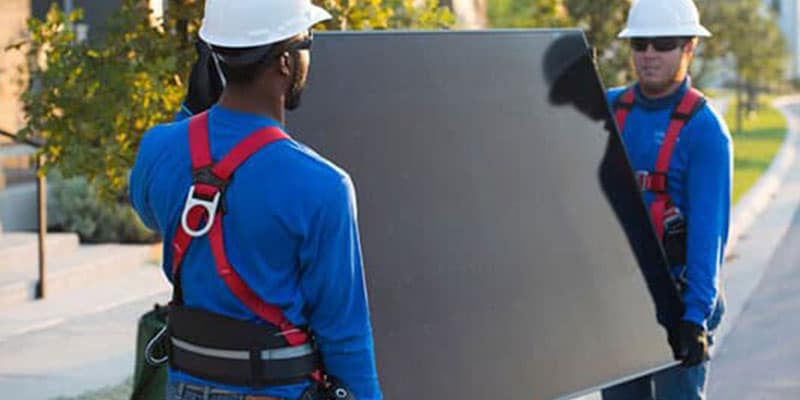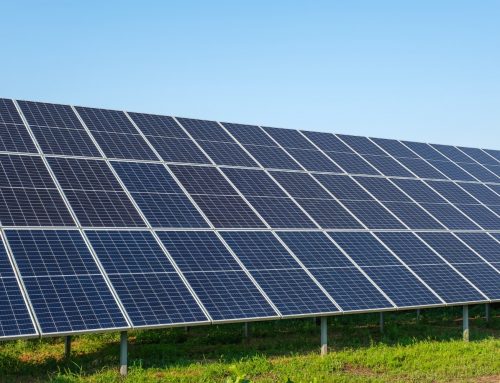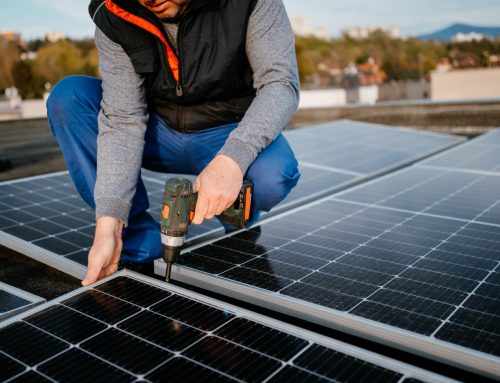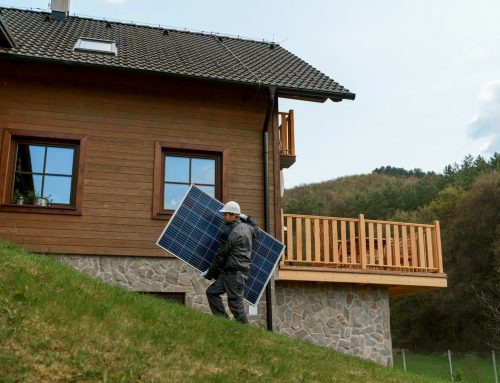In this guide, we’ll walk you through the process of installing solar panels in Adelaide.
Here’s what we’ll cover:
- A brief overview of renewable energy
- How to tailor solar solutions to your property
- Tips for choosing the right gear
- Simple step-by-step solar installation guide
Throughout this guide, we’ll delve into crucial considerations such as site assessment, choosing the right panels and inverters, understanding local regulations, and selecting a qualified installer.
We’ll break down the installation process into manageable steps, peppered with practical tips to maximise efficiency and minimise hassle.
By the end of this article, you’ll have a clear roadmap for installing solar panels, from initial contemplation to the exhilarating moment when you switch on your solar-powered system.
Solar Panels at a Glance
Solar panels convert sunlight into electricity, offering a renewable and clean energy source.
By installing solar panels, you can significantly reduce your dependence on traditional power sources, leading to a decrease in electricity bills.
One of the most compelling advantages of renewable power is its positive impact on the environment. By choosing renewable energy, you’re contributing to a reduction in carbon emissions, a major factor in global climate change.
Financially, panels are a wise investment. The initial setup cost is offset by the long-term savings on energy bills. Adelaide’s abundant sunshine means more energy production and potentially, greater savings.
Moreover, panels increase property value, making them not just an energy solution but also a real estate asset.
Another significant benefit is energy independence. Panels can reduce or even eliminate your reliance on the grid, giving you control over your energy usage and costs.
How to Tailor Solar Solutions to Your Home
Every home in Adelaide is unique, and so are its renewable energy needs.
Understanding your property’s specific requirements and equipping yourself with the right tools and resources is a critical step.
Assessing Your Home’s Solar Potential
- Sunlight Exposure: Factors like the orientation of your roof, any shading from trees or buildings, and the general climate conditions in your area will influence the efficiency of your panels.
- Roof Condition and Space: A sturdy, well-maintained roof is essential for supporting solar panels. Assess the available space and roof angle to determine the number and type of panels that can be installed.
- Energy Usage Patterns: Understanding your household’s energy consumption patterns helps in designing a system that meets your needs. Analysing your electricity bills can give you insights into your peak usage times and overall energy requirements.
How to Choose the Right Solar Gear
Selecting the right components is crucial for an efficient and long-lasting solar panel system in Adelaide.
This section offers a detailed overview of the essential components, along with recommendations for brands and types suitable for Adelaide’s climate.
Key Components of a Solar System
- Solar Panels: The heart of your system. In Adelaide’s sunny climate, photovoltaic (PV) panels are ideal. Look for panels with high efficiency and durability. Brands like SunPower are renowned for their performance and longevity (they have a 40-year warranty).
- Inverters: This device converts the DC electricity generated by your panels into AC power for home use. String inverters are cost-effective and suitable for most homes. For more complex roof layouts or shaded areas, microinverters or power optimisers from brands like Fronius or Enphase can offer better efficiency.
- Mounting System: Ensures the stability of your panels. In Adelaide’s varied weather conditions, choose a robust mounting system that can withstand strong winds and extreme weather. Brands like IronRidge and Unirac are known for their durable mounting systems.
- Battery Storage (Optional): To store excess energy for later use. In Adelaide, where sunlight is plentiful, having a battery can maximise your investment. Tesla Powerwall and LG Chem are popular choices for their efficiency and reliability.
Solar System Installation Guide
Step 1: Site Survey and Planning
– Professional Assessment: Begin with a professional assessment of your roof’s condition and solar potential.
– Safety First: Ensure that the roof is safe for installation. If in doubt, consult a professional.
– Design Layout: Plan the layout of the panels considering sunlight exposure and roof space.
Step 2: Installing Mounts
– Mount Type: Choose between flush mounts or roof-ground mounts based on your roof type.
– Alignment: Ensure mounts are aligned properly for maximum efficiency.
– Secure Mounting: Follow manufacturer instructions to securely attach mounts to your roof.
Safety Tip: Working at heights is risky. Use safety harnesses and ensure stable footing. If uncomfortable, hire a professional.
Step 3: Placing the Solar Panels
– Attach Panels: Place the panels on the mounting structure.
– Wiring: Connect the panels to your power system. This should be done by a certified electrician to ensure safety and compliance.
Caution: Electrical work requires expertise. It’s time to call in a professional electrician.
Step 4: Installing the Inverter and Battery System
– Location: Install the inverter and battery system in a cool, shaded area.
– Connection: Connect the inverter to the panels and battery, if applicable.
Reminder: Handling electrical components poses risks. Professional installation is recommended.
Step 5: Connecting to the Grid
– Grid Connection: Have a qualified electrician connect your system to the grid.
– Inspections and Approvals: Ensure your system is inspected and approved by local authorities.
Important: This step must be performed by a licensed professional.
Step 6: Testing and Commissioning
– System Check: Test the solar system to ensure it operates correctly.
– Professional Review: Have the installation reviewed by a professional.
Best Practice: Always have a final review by a certified installer to confirm everything is up to standard.
By following these steps and recognising when professional expertise is needed, you can ensure a safe and successful installation.
Remember, safety is paramount, and professional installers are there to help when the task goes beyond DIY capabilities.
Solar Panel System Cost Breakdown
| Component | Average Cost | Notes |
|---|---|---|
| Solar Panels | $3,000 – $7,000 | Varies based on quality and capacity. |
| Inverter | $1,000 – $2,000 | Depending on type and capacity. |
| Installation | $2,000 – $4,000 | Varies by complexity and location. |
| Additional Costs | $500 – $2,000 | Permits, inspections, and misc. |
| Total | $6,500 – $15,000 |
Note: Prices are indicative and can vary based on specific requirements and market changes.
Government Incentives and Subsidies
Australia offers various incentives to encourage the adoption of renewable energy:
- Small-scale Renewable Energy Scheme (SRES): Offers small-scale technology certificates (STCs) which can be sold to recoup some costs.
- Local Government Grants and Subsidies: Some local councils in Adelaide offer additional incentives for solar installation.
- Feed-in Tariffs: Earn credits for surplus power fed back into the grid.
To learn more about these incentives and how to apply, visit the Australian Government’s Clean Energy Regulator and your local council’s website.
Quick Budgeting and Cost-Saving Tips
- Get Multiple Quotes: Shop around and get quotes from different installers to find the best deal.
- Quality vs. Cost: Balance between initial costs and long-term savings. Higher-quality panels might be more expensive but can offer more savings over time.
- Plan for Future Needs: Consider future energy needs to avoid costly upgrades later.
- Monitor Energy Usage: Use energy monitoring tools to maximise your system’s efficiency and reduce waste.
- Maintenance: Factor in the cost of maintenance and repairs in your budget.
Investing in renewable energy in Adelaide requires careful financial planning, but with the available incentives and the long-term savings on energy bills, it’s a worthwhile investment.
Adelaide Solar Solutions: Key Takeaways
Let’s recap the key points we’ve learned so far:
- Harnessing Adelaide’s Sun: Adelaide’s sunny climate makes it ideal for renewable energy, promising both environmental and financial benefits.
- Step-by-Step Installation: From assessing your property’s solar potential to the actual installation, we’ve covered each step to ensure a smooth process.
- Choosing the Right Components: Selecting high-quality panels, inverters, and mounting systems is crucial for the efficiency and longevity of your system.
- Professional Help is Key: Knowing when to seek professional help, especially for electrical work and final inspections, ensures safety and compliance.
- Financial Considerations: The cost varies, but government incentives and long-term savings make it a wise investment.
- Environmental Impact and Compliance: While renewable energy is eco-friendly, it’s important to consider environmental impacts and adhere to local regulations.
Installing solar panels in Adelaide is a journey that intertwines with careful planning, an understanding of local regulations, and a keen eye on quality and safety.
With the right approach, you can unlock the full potential of renewable energy, contributing to a sustainable future while enjoying the financial and environmental rewards.
Ready to Make the Switch to Solar? Contact Energy Buster Today!
If you’re ready to take the next step or have any questions, the team at Energy Buster is here to help.
- Personalised Advice: Our team of experts is eager to provide you with personalised advice that aligns with your specific needs and goals.
- Get a Custom Quote Every home is unique, and so are your energy needs. Contact us for a custom quote that caters to your specific requirements.
- Experience and Expertise: With our experience and expertise, we ensure that your transition to renewable energy is seamless, efficient, and tailored to your expectations.
Reach out to Energy Buster today, and take a significant step towards a sustainable and cost-effective energy future.






